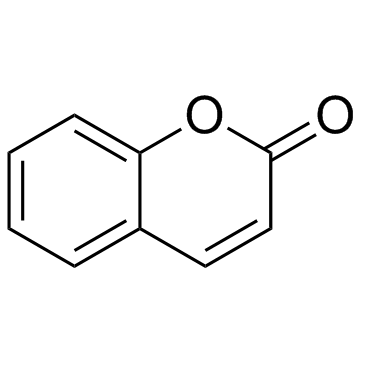Coumarin

Coumarin structure
|
Common Name | Coumarin | ||
|---|---|---|---|---|
| CAS Number | 91-64-5 | Molecular Weight | 146.143 | |
| Density | 1.2±0.1 g/cm3 | Boiling Point | 298.0±0.0 °C at 760 mmHg | |
| Molecular Formula | C9H6O2 | Melting Point | 68-73 °C(lit.) | |
| MSDS | Chinese USA | Flash Point | 118.3±16.1 °C | |
| Symbol |

GHS06 |
Signal Word | Danger | |
|
Proteasome functioning in breast cancer: connection with clinical-pathological factors.
PLoS ONE 9(10) , e109933, (2014) Breast cancer is one of four oncology diseases that are most widespread in the world. Moreover, breast cancer is one of leading causes of cancer-related deaths in female population within economically developed regions of the world. So far, detection of new m... |
|
|
Mitochondrial targeting of bilirubin regulatory enzymes: An adaptive response to oxidative stress.
Toxicol. Appl. Pharmacol. 282(1) , 77-89, (2015) The intracellular level of bilirubin (BR), an endogenous antioxidant that is cytotoxic at high concentrations, is tightly controlled within the optimal therapeutic range. We have recently described a concerted intracellular BR regulation by two microsomal enz... |
|
|
Pre-clinical evaluation of AZD-2014, a novel mTORC1/2 dual inhibitor, against renal cell carcinoma.
Cancer Lett. 357(2) , 468-75, (2015) Here we found that dual mTORC1/2 inhibitor AZD-2014 significantly inhibited RCC cell survival and growth, with higher efficiency than conventional mTORC1 inhibitors rapamycin and RAD001. RCC cell apoptosis was also induced by AZD-2014. AZD-2014 disrupted mTOR... |
|
|
In vitro assessment of the multifunctional bioactive potential of Alaska pollock skin collagen following simulated gastrointestinal digestion.
J. Sci. Food Agric. 95(7) , 1514-20, (2015) Dietary mineral deficiency, hypertension and diabetes have become serious human health problems. Dietary approaches are increasingly being investigated to address these issues. Identification of food-derived biological peptides has become an important approac... |
|
|
The Japanese toxicogenomics project: application of toxicogenomics.
Mol. Nutr. Food. Res. 54 , 218-27, (2010) Biotechnology advances have provided novel methods for the risk assessment of chemicals. The application of microarray technologies to toxicology, known as toxicogenomics, is becoming an accepted approach for identifying chemicals with potential safety proble... |
|
|
Novel Marmoset Cytochrome P450 2C19 in Livers Efficiently Metabolizes Human P450 2C9 and 2C19 Substrates, S-Warfarin, Tolbutamide, Flurbiprofen, and Omeprazole.
Drug Metab. Dispos. 43 , 1408-16, (2015) The common marmoset (Callithrix jacchus), a small New World monkey, has the potential for use in human drug development due to its evolutionary closeness to humans. Four novel cDNAs, encoding cytochrome P450 (P450) 2C18, 2C19, 2C58, and 2C76, were cloned from... |
|
|
Modulation of cytochrome P450 2A5 activity by lipopolysaccharide: low-dose effects and non-monotonic dose-response relationship.
PLoS ONE 10(1) , e0117842, (2015) Mouse cytochrome P450 (CYP) 2A5 is induced by inflammatory conditions and infectious diseases that down-regulate the expression and activity of most other CYP isoforms. Enhanced oxidative stress and nuclear factor (erythroid 2-related factor) 2 (Nrf2) transcr... |
|
|
Coumarins as new matrices for matrix-assisted laser-desorption/ionization Fourier transform ion cyclotron resonance mass spectrometric analysis of hydrophobic compounds.
Anal. Chim. Acta 882 , 49-57, (2015) Hydrophobic compounds with hydroxyl, aldehyde or ketone groups are generally difficult to detect using matrix-assisted laser desorption/ionization mass spectrometry (MALDI-MS), because these compounds have low proton affinity and are poorly ionized by MALDI. ... |
|
|
Metabolic characterization of meso-dihydroguaiaretic acid in liver microsomes and in mice.
Food Chem. Toxicol. 76 , 94-102, (2015) meso-Dihydroguaiaretic acid (MDGA) is a major component of Myristica fragrans and Machilus thunbergii that is traditionally used as a spice and for medicinal purposes. Despite reports of various biological activities exerted by MDGA, there is no information r... |
|
|
Evaluation of thein vitro/in vivodrug interaction potential of BST204, a purified dry extract of ginseng, and its four bioactive ginsenosides through cytochrome P450 inhibition/induction and UDP-glucuronosyltransferase inhibition
Food Chem. Toxicol. 68 , 117-27, (2014) • BST204 is a purified dry extract of ginseng containing high amounts of Rh2 and Rg3. • BST204 had only weak inhibitory effects on nine CYPs and five UGTs. • It is unlikely that BST204 alter pharmacokinetics of drugs metabolized by CYPs/UGTs. |